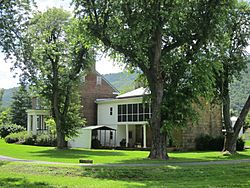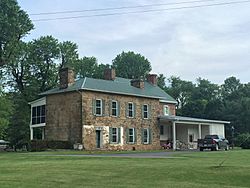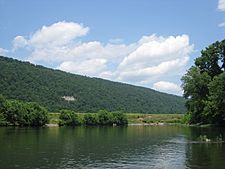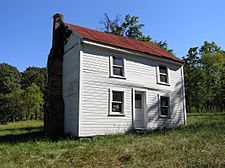Wappocomo (Romney, West Virginia) facts for kids
Quick facts for kids Wappocomo |
|
|---|---|

Wappocomo viewed from Cumberland Road (West Virginia Route 28) in July 2013.
|
|
| General information | |
| Type | Residential |
| Architectural style | Georgian |
| Location | Cumberland Road (West Virginia Route 28), Romney, West Virginia |
| Country | United States |
| Coordinates | 39°21′37″N 78°45′10″W / 39.360345°N 78.752835°W |
| Completed | 1774 (main house) 1861 (stone addition) |
| Client | Nicholas Casey (1774) Col. Isaac Parsons (1861) |
| Owner | Peter Casey Nicholas Casey James Gregg Parsons Col. Isaac Parsons Susan Blue Parsons Garrett Williams Parsons Charles Heber Parsons Charles Heber Parsons, Jr. Charles Heber Parsons III Charles Heber Parsons IV Garrett Timothy Parsons Jr. |
Wappocomo is a historic mansion and farm built in the late 1700s. It sits on a hill overlooking the South Branch Potomac River near Romney, West Virginia. The house is known for its beautiful Georgian architecture style. It is located along Cumberland Road (West Virginia Route 28) and the South Branch Valley Railroad.
The main part of the Wappocomo mansion was built in 1774 by Nicholas Casey. He used special bricks that had traveled all the way from England! These bricks were used as ballast (heavy material to keep ships steady) on ships carrying tobacco from the James River. The land where Wappocomo stands was once part of a huge land grant owned by Thomas Fairfax, 6th Lord Fairfax of Cameron. The Parsons family later bought Wappocomo and has owned it for many generations, right up to today.
Wappocomo was involved in two important events related to slavery. These events caused disagreements between the governments of Pennsylvania and Virginia. In 1788, Nicholas Casey bought a man named John, who had been freed in Pennsylvania but was then forced back into slavery in Virginia. Pennsylvania's governor asked Virginia to punish those responsible, but Virginia's governor said there was no law for it in the Constitution of the United States. Later, in 1855, a man named Jacob Green, who was enslaved at Wappocomo, escaped to Pennsylvania with others. This led to a big argument between the states about a law called the Fugitive Slave Act of 1850.
What makes Wappocomo special is that its main front (called the façade) faces the road and the mountains, not the river. Most other old homes along the South Branch Potomac River face the water. The original 1774 house is a square, two-story building in the Georgian style, which was popular in Virginia back then. Inside, it has a grand staircase and original handmade wooden details. In 1861, a stone addition was built with two levels of deep verandas (porches). Today, the main train station for the Potomac Eagle Scenic Railroad, called Wappocomo Station, is located right at the farm.
Exploring Wappocomo's Past
How Wappocomo Was Built
The land where Wappocomo stands was originally part of a huge area called the Northern Neck Proprietary. This was a large land grant given by King Charles II of England in 1649. Over time, this land grant ended up with Thomas Fairfax, 6th Lord Fairfax of Cameron in 1719.
Lord Fairfax chose a part of this land for his own large estate. This area, known as the South Branch Survey, stretched along the South Branch Potomac River. In 1748, Lord Fairfax had the land surveyed into lots, each about 300 to 400 acres, to be sold or leased.
Peter Casey, an important pioneer in Hampshire County, West Virginia, received Lot Number 21, which is where Wappocomo is located. His son, Nicholas Casey, inherited this land. In 1774, Nicholas built the beautiful mansion we see today.
The bricks used to build Nicholas Casey's mansion came from England. They were used as ballast on ships that carried tobacco from the James River. After arriving in America, these bricks were then transported by bullock carts (carts pulled by oxen) over the Blue Ridge Mountains to the building site. The name "Wappocomo" comes from the Native American word "Wappatomaka," which was their name for the South Branch Potomac River.
Early Challenges and Laws
In 1788, while living at Wappocomo, Nicholas Casey bought a man named John. John had been a freed slave living in Washington County, Pennsylvania. However, three men from Virginia captured John and brought him back to Virginia, where they sold him into slavery to Casey. This was against the law in Pennsylvania. The Pennsylvania Abolition Society asked Pennsylvania's governor, Thomas Mifflin, to demand that Virginia punish these men. Virginia's governor refused, saying the Constitution of the United States did not have a rule for such a situation. Governor Mifflin then asked the United States Congress to create a law to prevent this from happening again.
In 1789, Nicholas Casey was appointed as a trustee for the town of Romney, West Virginia. He worked with others to settle land disputes and to clear the town's streets.
The Parsons Family Takes Over
Nicholas Casey's daughter, Mary Catherine Casey, married James Gregg Parsons in 1795. The Parsons family was very important in the area, with ancestors who came from England in 1635. James Gregg Parsons' father, Isaac Parsons, was a member of the Virginia House of Delegates (like a state representative) from 1789 until his death.
James Gregg Parsons and his wife Catherine inherited Wappocomo from her father. They raised their 12 children in the mansion. After James Gregg Parsons passed away, his son, Colonel Isaac Parsons, inherited Wappocomo in 1847. Colonel Parsons was also a member of the Virginia House of Delegates from 1854 to 1857.
The Jacob Green Story
In August 1855, Jacob Green, a man enslaved by Colonel Parsons, escaped from Wappocomo with four other enslaved people. In October, he returned and helped four or five more enslaved people from nearby farms escape to Pennsylvania.
Colonel Parsons and some of his relatives went north to find them. They caught two of the escaped individuals, who were sent back. With information from them, Colonel Parsons and his nephews went to different towns in Pennsylvania, hoping to stop Green. One of his nephews, James "Zip" Parsons III, found Green, but people who supported freedom for enslaved people (called abolitionists) stopped him. James Parsons III was arrested for kidnapping.
When Colonel Parsons heard about his nephew's arrest, he asked for help from important politicians like Charles J. Faulkner and James Murray Mason. The Virginia General Assembly (Virginia's state government) promised to support Parsons and other slaveowners. Virginia's governor even sent a special representative to the trial. The disagreement between Virginia and Pennsylvania became so serious that a newspaper article in 1856 called it a "Threatened Civil War."
Colonel Parsons, Faulkner, and the Virginia representative went to the trial. Faulkner defended James Parsons III, arguing that he had acted legally under the Fugitive Slave Act of 1850. James Parsons III was found not guilty.
Life and Events at Wappocomo
After the stone addition was built in 1861, the large room upstairs became a ballroom. Many parties and events were held there. It's said that as many as 100 couples have danced on its wooden floor! It was a tradition for first-time visitors to write their names and the date on the mortar between the stone blocks. Many of these signatures can still be seen today.
Wappocomo During the Civil War
During the American Civil War, Colonel Parsons received permission from the Confederate government to create a small group of soldiers to defend the border. He gathered about 30 men, and they became known as the Huckleberry Rangers. Colonel Parsons often provided food and horses from his Wappocomo farm to Confederate soldiers.
One time, Colonel Parsons was trying to get back to Wappocomo to check on his family and get some supplies. He had to travel secretly through the night and rain to avoid Union Army soldiers who were guarding the house. His nephew and another man helped him get a parcel from his daughter, Kate, without being seen by the guards. After a difficult journey, they eventually made it to safety.
After the War

Colonel Parsons died in 1862, during the Civil War. His wife, Susan Blue Parsons, inherited Wappocomo. She used the farm to raise and educate their children.
In 1884, the Baltimore and Ohio Railroad built a train line that went right through the Wappocomo property, crossing the front lawn of the mansion. This line later became part of the South Branch Valley Railroad in 1978.
The Parsons family continued to own Wappocomo. Garrett Williams Parsons bought the property from the other heirs in 1890. His son, Charles Heber Parsons, inherited it next and continued farming there. Then, his son, Charles Heber Parsons, Jr., and his wife owned it.
In 1991, the Potomac Eagle Scenic Railroad began operating on the South Branch Valley Railroad. Its main station, Wappocomo Station, is located on the farm. The ticket office is even in a red 1940 train car called a caboose!
Part of the original Wappocomo land was sold for homes and a fruit storage facility near Romney. Charles "Chuck" Heber Parsons III, Charles Heber Parsons, Jr.'s son, inherited the farm and carefully restored it. He was a respected member of the Romney community and served as Assistant Chief of the Romney Volunteer Fire Department. After his passing in 2012, his children, Charles "Chip" Heber Parsons IV and Jillyn Marie Parsons, inherited Wappocomo.
Wappocomo's Design
Outside the Mansion
The original part of the Wappocomo mansion, built in 1774, is a square, two-story building with a basement and attic. It's built in the Georgian architecture style, which was popular in Virginia at the time. The walls are very thick, about 1 foot 6 inches deep, because they are made of heavy ballast bricks. This creates deep window sills. The house also has two chimneys on either side. The main entrance has a small porch (called a portico) with wooden columns.
Most historic homes along the South Branch Potomac River face the river. But Wappocomo is special because its main front faces Cumberland Road and the mountains. This might be because the house is about half a mile from the river. However, the second-floor windows at the back of the house offer a beautiful view of the South Branch Potomac River.
Inside the Mansion
The wooden parts of the house, like the sill plates (bottom timbers) and joists (support beams), were sawed by hand. The "rot nails" used in construction were made right there in the blacksmith shop on the Wappocomo farm. The house also has very tall fireplace mantelpieces, wide window moldings, solid paneled doors, and beautiful handmade wooden details throughout. Every room in the main part of the house originally had a corner fireplace.
Both floors of the mansion have four large rooms with high ceilings, and all the rooms are the same size. A grand staircase is located at the end of the central hall, going from the first floor all the way to the attic. The handrail of the staircase is made of walnut wood.
The basement rooms at Wappocomo are mostly above ground. The house's foundation is made of large stone blocks. In the basement, there's a big open fireplace that used to have a swinging iron chimney crane for cooking. This area in the basement was once the main kitchen. You can enter the basement through a wide, heavy door from outside.
The Stone Addition
In 1861, a stone addition was built onto the original 1774 house. The large stone blocks for this addition came from Mill Creek Mountain, a ridge across the South Branch Potomac River from the mansion. The stones were cut and then brought across the river to the house. A man named Mr. Ferrybe oversaw the building of this stone addition.
The 1861 stone addition has two floors, with two large rooms on each floor and 12-foot-high ceilings. The two upstairs rooms were combined to create a large ballroom. The two downstairs rooms were used as a dining room and a kitchen.
The stone addition also has two deep verandas (porches) on its eastern front. These verandas were once supported by tall columns. An outside staircase used to connect the lower porch to the upper porch.
Wappocomo's Location
The Wappocomo farm is located in the flat floodplain (flat land next to a river) of the South Branch Potomac River valley, just north of Romney. The farm borders the Valley View farm and the edge of Romney to the southwest. The South Branch Potomac River is to the west and north, and the South Branch Valley Railroad and Cumberland Road (West Virginia Route 28) are to the east.
Mill Creek Mountain, a narrow mountain ridge, rises to the west across the river. The western hills of South Branch Mountain are to the east. These mountains are covered in forests of hardwoods and pine trees. Hanging Rocks, which are cliffs made of layers of sandstone and limestone, are located about 3 miles north of Wappocomo farm. This is where the South Branch Potomac River cuts through Mill Creek Mountain. There's even a small community nearby also called Wapocomo.
Big Run, a smaller stream that flows into the South Branch Potomac River, runs through the Wappocomo property. Another smaller stream flows through the front lawn of the house before joining Big Run. The main crop grown in Wappocomo's fields along the river is corn, thanks to the rich alluvial soils (soil deposited by rivers).
Washington Place
In 1874, Colonel Parsons' widow, Susan Blue Parsons, sold 2 acres of Wappocomo's land to William Washington, a freedman (a formerly enslaved person), and his family. William Washington had worked on a farm called Washington Bottom Farm, and he took his owner's last name. This deed allowed the Washington family to live on that land as long as any of the people named in the deed were alive. Later, in 1892, Garrett Williams Parsons sold them an additional 3 acres. The old log house built by William Washington on this land is now known as Washington Place. It is believed to be one of the first homes built by freed slaves in Hampshire County.
|







